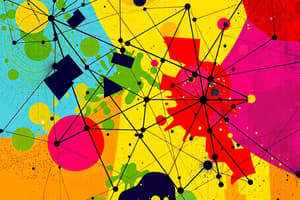Podcast
Questions and Answers
What is the main concept that computer science borrowed from mathematics?
What is the main concept that computer science borrowed from mathematics?
- Logic
- Data Structures
- Algorithms
- Graph Theory (correct)
What is the formal definition of a graph?
What is the formal definition of a graph?
- A set of edges and vertices
- A network of nodes and connections
- A pair of vertices and a set of edges (correct)
- A collection of interconnected objects
What are the two main components of a graph?
What are the two main components of a graph?
- Edges and networks
- Vertices and edges (correct)
- Vertices and algorithms
- Nodes and data structures
What does the term 'adjacency' refer to in graph theory?
What does the term 'adjacency' refer to in graph theory?
What is the set of vertices denoted as in the graph G = (V, E)?
What is the set of vertices denoted as in the graph G = (V, E)?
What is a path in a graph?
What is a path in a graph?
In an adjacency matrix, what do the rows and columns represent?
In an adjacency matrix, what do the rows and columns represent?
What is a disconnected graph?
What is a disconnected graph?
What does an entry of '1' in an adjacency matrix indicate?
What does an entry of '1' in an adjacency matrix indicate?
What type of graph has edges with no specific direction?
What type of graph has edges with no specific direction?
Study Notes
Graph Theory Introduction
- Graph theory is a branch of mathematics that studies graphs, which are a way to formally represent a network.
- Graph theory has been borrowed by computer science to study and represent networks.
Graph Representation
- There are two main ways to represent a graph:
- Adjacency Matrix: a 2-dimensional array of V x V vertices, where each row and column represent a vertex, and the presence of an edge is represented by a 1, and the absence of an edge is represented by a 0.
- Adjacency List: an array of linked lists, where the index of the array represents a vertex, and each element in its linked list represents the other vertices that form an edge with the vertex.
Adjacency Matrix
- A two-dimensional array of V x V vertices, where each row and column represent a vertex.
- A way of representing a graph as a matrix of Boolean values (0's and 1's).
Adjacency List
- An array of linked lists, where the index of the array represents a vertex.
- Each element in its linked list represents the other vertices that form an edge with the vertex.
Graph Types
- Directed Graph: a graph in which each edge has a direction.
- Undirected Graph: a graph in which each edge does not have a direction.
- Connected Graph: a graph where every node can be visited from other nodes.
- Disconnected Graph: a graph in which at least one node is not reachable from another node.
Graph Terminologies
- Adjacency: a vertex is said to be adjacent to another vertex if there is an edge connecting them.
- Path: a sequence of edges that allows you to go from vertex A to vertex B.
Formal Definition of a Graph
- A graph (G) is a pair of vertices (V) and a set of edges (E), denoted as 𝐺=(𝑉, 𝐸).
Components of a Graph
- There are two main parts of a graph:
- Vertices or nodes: where the data is stored.
- Edges or connections: which connect the nodes.
Studying That Suits You
Use AI to generate personalized quizzes and flashcards to suit your learning preferences.
Description
Explore the fundamentals of Graph Theory, including graph representation, types of graphs, and applications in computer science. Learn how graph data structures are used in computing and the relationship between graphs and logic and mathematics.




